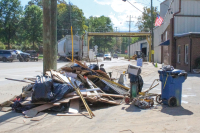Engineers still honing plan to stabilize remnants of Maggie landslide
Once repair work is complete, a precarious Maggie Valley mountainside destabilized by a major mudslide will be returned to its natural state.
The hard part will be getting to that point.
Last Wednesday, anxious residents downslope of the slide along with town leaders gathered to hear the plan of attack. Three engineers from McGill Associates and Bunnell-Lammons presented their preliminary reports, which recommend methods for both stabilizing the slope and restoring a displaced stream to its original path.
The top of the mountain was leveled more than 40 years ago to make way for Ghost Town in the Sky amusement park. Unwanted dirt was pushed over the side of the mountain in the process.
Engineers want to remove that fill soil and re-grade the slope to its natural state, peeling back the layers until they reach the contour of the original mountainside.
For now, it is unclear how exactly contractors will go about their work without setting off another slide, however. Town Manager Tim Barth said he is not sure who would be liable if another slide were to occur.
Related Items
Without repair, however, a slide of the same or even greater magnitude than the last one could occur, according to Bunnell-Lammon, which is in charge of the slope stabilization part.
The state geologist earlier said up to 16,000 tons of loose material threatens the mountainside. Homes below have been left endangered ever since February’s slide, which left a 3,000 feet wake of destruction down the mountainside.
In engineering terms, a “factor of safety” of 1.0 or less indicates an “impending or active slope failure.” The upper portion of the slope now has a factor of safety of 0.6. Bunnell-Lammons recommends a minimum a factor of safety of 1.3, but preferably 1.5.
While the “how” of the plan is still being formulated, one thing is clear, use of major equipment will be minimal.
“Some of those jobs, it’s shovels and wheelbarrows,” said J.P. Johns, an engineer with McGill.
“This is not going to be a scenario where we get large pieces of equipment up there working around,” said Randy Hintz, project manager with McGill. “This is more likely going to be a situation where we have bobcats (small graders) and mini-excavators up there working.”
Red tape
The primary source of funding for the approximately $1.4 million project will come from a federal grant, while N.C. Department of Transportation will fund much of the rest. Meanwhile, Ghost Town and the Town of Maggie Valley say they will contribute $25,000 each.
All work will be supervised by qualified field specialists, who will be on site to approve even the most minor changes to the official plan. Contractors must be certified by the DOT and demonstrate a minimum of three similar jobs completed successfully.
Barth says he is hopeful it will take no longer than two to three months for the work to be completed once it begins.
McGill is waiting to receive necessary permits before it can hire a contractor to start work. The firm anticipates that a permit from the Department of Environment and Natural Resources could take up to 30 days.
Even after that, the DOT will require engineers to put the job out to bid for a minimum of 21 days.
That announcement left the crowd stunned at Wednesday’s meeting.
“That’s ridiculous,” someone whispered.
“Is there no way to expedite the 51 days you were talking about?” asked Mayor Roger McElroy. “That seems to me like an unreasonable time.”
Hintz responded that since North Carolina has not declared a state of emergency — like the town of Maggie Valley and Haywood County did in February — his firm has little choice but to follow the normal protocol for publicly-funded jobs.
“In order to get the state funds to participate in this project, it must go through all the same channels,” said Hintz, while reassuring residents that the project has moved forward since February. “We’ve accomplished an awful lot at this point.”
Resident Kurt Biedler asked specifically if debris would be removed from his house, one of the five worst damaged by the slide.
“I mean these are things that are very important to me right now: trees, rocks, guardrails, timber,” said Biedler, who has moved to Arden for now.
Hintz said he would have to check with the funding agency before he could answer. “We have been given a very narrow focus on the types of things we can spend this money on,” said Hintz.
As part of the stabilization process, a road on Ghost Town’s property that sits on top of the fill dirt will be dismantled. The road is key to getting from one part of the amusement park to another. It will not be rebuilt by contractors working on the project.
According to Bunnell-Lammons, it appears the landslide started at Ghost Town’ retaining wall, where the fill soil placed with the MSE walls met underlying residual soil. Those MSE walls will be removed as part of the repair process.
Bunnell-Lammons stated in its report that it had been specifically directed not to determine the cause of the slide or evaluate the parties responsible for the slide.
“Our scope of work is how to immediately repair it,” said Will Gentry, a Bunnell-Lammons engineer. “We have not gone into why did it fail and how did it fail.”
Creek restoration
Meanwhile, mud, downed trees, and other debris have stopped up culverts where the creek crossed Rich Cove Road three times on its way down the mountain. The landslide also created a wide, long swath now prone to erosion.
To restore the stream, McGill’s plan recommends removing mud, downed trees, and other debris from three culvert crossings along Rich Cove Road. Currently, the blocked up culverts are forcing the stream to divert from its natural path.
Contractors will work upstream to downstream in the upper section, then downstream to upstream in the lower portion in order to work “dry.”
The removed trees would be ground up into wood mulch, which will be spread out on the mountain slope. This will minimize how much material contractors have to deliver up the steep slope.
“We’re going to try to limit the hauling out and the hauling in,” said Johns.
“Speed bumps,” made of mulch will be installed to slow down water as it flows down the slope.
Vegetation will be re-established with native species as much as possible, though a true restoration will be difficult to accomplish with the limited funding that’s available.
The first priority, however, will be to address the unstable slope at the top of the mountain.
“We don’t want to do any work down below until we get the top stabilized,” said J.P. Johns, an engineer with McGill.









